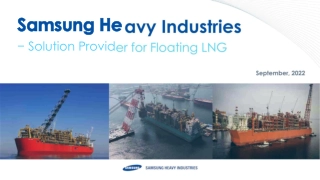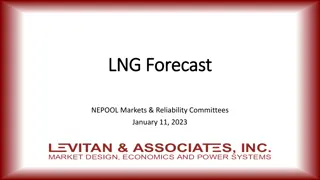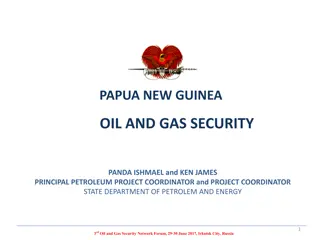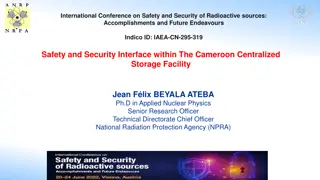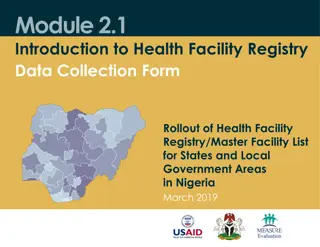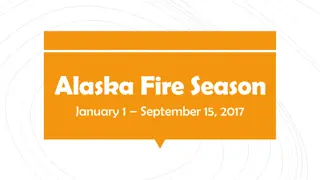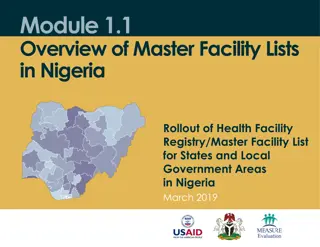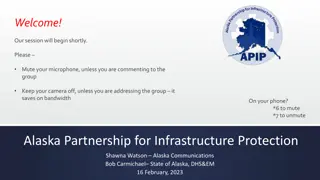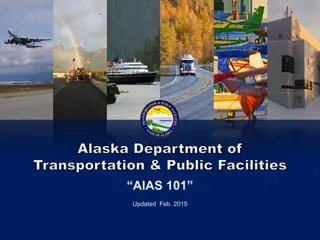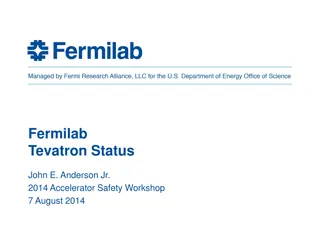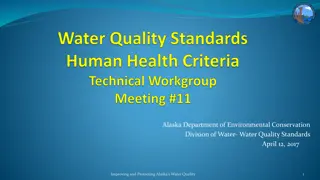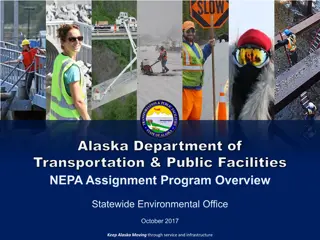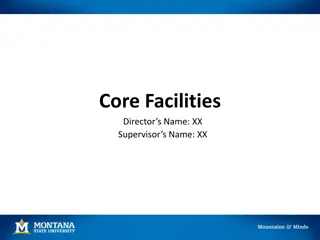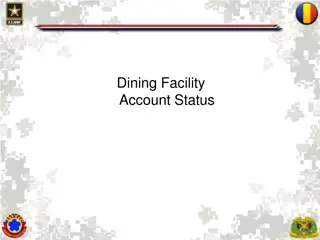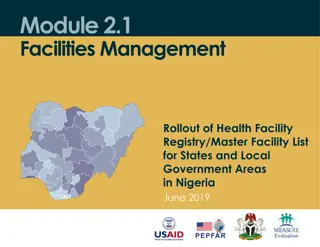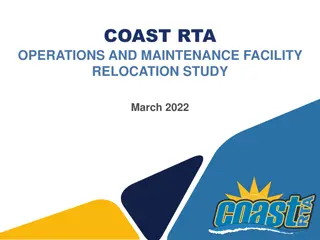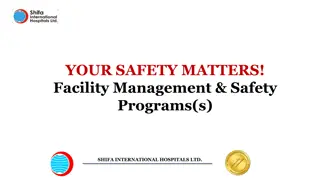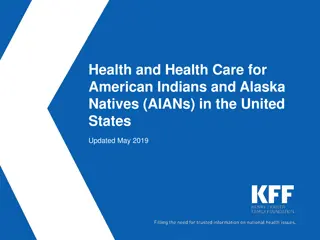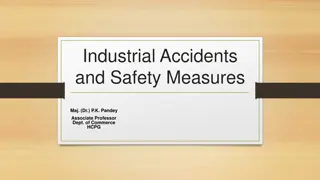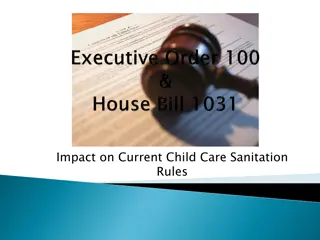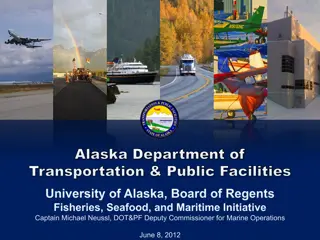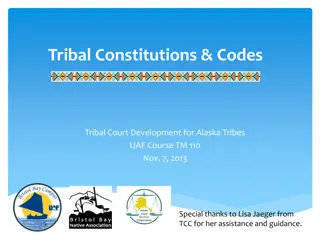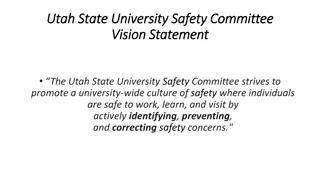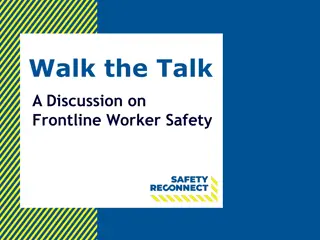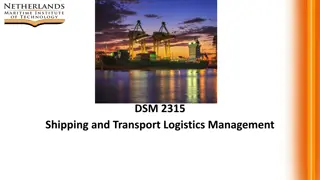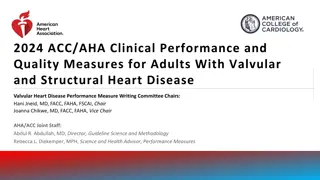Safety Measures at Alaska LNG Liquefaction Facility
This document highlights the safety procedures and measures implemented at the Alaska LNG Liquefaction Facility and Marine Terminal. It covers topics such as hazard analysis, emergency response plans, flares, noise, seismic design, and more. The facility overview includes details on the modularized liquefaction plant, storage tanks, marine jetty, and execution basis. The Hazard Analysis Report outlines evaluations for various hazardous scenarios to ensure public safety and compliance with FERC and DOT regulations.
Download Presentation

Please find below an Image/Link to download the presentation.
The content on the website is provided AS IS for your information and personal use only. It may not be sold, licensed, or shared on other websites without obtaining consent from the author. Download presentation by click this link. If you encounter any issues during the download, it is possible that the publisher has removed the file from their server.
E N D
Presentation Transcript
Process Safety At the Alaska LNG Liquefaction Facility and Marine Terminal April 12, 2018 Leslie Fritz Krusen AKLNG-4030-PPP-PRS-DOC-00001
Agenda LNG Site Overview Hazard Analysis Report Flares Noise Seismic Design Emergency Response Plan 2
Agenda LNG Site Overview Hazard Analysis Report Flares Noise Seismic Design Emergency Response Plan 3
LNG Site Overview Summary Highly modularized 3 train liquefaction plant - 6.7 MTPA each About 900 acres of land required Design Basis Air Products C3MRTM process; two refrigeration cycles C3 = Propane MR = Mixed Refrigerant (mix of propane, ethane, & nitrogen) Power plant (combined cycle), with distribution system optimized to reduce capex; Black-Start tie in to local utility 2 x 240,000 m3 LNG storage tanks Marine jetty with 2 loading berths, LNG loading rate 12,500 m3/hr Execution Basis Material Offloading Facility (MOF) to support the unloading of bulk materials, modules, and construction equipment; Temporary facility 4
Agenda LNG Site Overview Hazard Analysis Report Flares Noise Seismic Design Emergency Response Plan 6
Hazard Analysis Report - Overview Required by FERC and DOT PHMSA to evaluate hazards associated with: Flammable Gas Dispersion (vapor dispersion exclusion zone) Pool Fires (thermal radiation exclusion zone) Jet Fires (hazard zone) Refrigerant vapor dispersion (hazard zone) Overpressure from ignition of flammable refrigerants (hazard zone) Toxic vapor dispersion (hazard zone) All piping has a hole size associated with it based on DOT PHMSA FAQ website Piping table has been created to list every piece of pipe in the facility along with its hole size over 140 release scenarios have been evaluated Modeling is performed on the bounding scenarios to ensure hazards do not impact the public 18 bounding scenarios have been selected. 7
Hazard Analysis Report Gas Release Flammable Gas Dispersion for LNG (1/2 LFL) Purple = release from loading line at jetty Blue = release from loading line on shore Green = release from LNG rundown lines 8
Hazard Analysis Report Pool Fire Pool Fires for Process Areas Yellow = low flux (1,600 Btu/ft2-hr) Orange = medium flux (3,000 Btu/ft2-hr) Red = high flux (10,00 Btu/ft2-hr) 9
Hazard Analysis Report Pool Fire Pool Fires for LNG Tanks Yellow = low flux (1,600 Btu/ft2-hr) Orange = medium flux (3,000 Btu/ft2-hr) Red = high flux (10,00 Btu/ft2-hr) 10
Hazard Analysis Report Jet Fire Jet Fires for LNG, low flux (1,600 Btu/ft2-hr) Purple = release from unloading line at jetty Blue = release from unloading line on shore Green = release from LNG rundown lines 11
Hazard Analysis Report Jet Fire Jet Fires for Mixed Refrigerant, low flux (1,600 Btu/ft2-hr) Purple = MCHE release Green = HP MR Compressor outlet release 12
Hazard Analysis Report Jet Fire Jet Fires for Propane Refrigerant, low flux (1,600 Btu/ft2- hr) Green = Propane Storage Bullet Blue = Propane subcooler outlet Purple = connection on propane cooler Orange = release from reflux drum 13
Hazard Analysis Report Gas Release Refrigerant vapor dispersion for mixed refrigerant (1/2 LFL) Purple = MCHE release Green = HP MR Compressor outlet release 14
Hazard Analysis Report Gas Release Refrigerant vapor dispersion for propane refrigerant (1/2 LFL) Green = Propane Storage Bullet Blue = Propane subcooler outlet Purple = connection on propane cooler Orange = release from reflux drum 15
Hazard Analysis Report - Overpressure Overpressure from mixed refrigerant ignition (1 psi) Purple = MCHE release Green = HP MR Compressor outlet release 16
Hazard Analysis Report - Overpressure Overpressure from propane refrigerant ignition (1 psi) Green = Propane Storage Bullet Blue = Propane subcooler outlet Purple = connection on propane cooler Orange = release from reflux drum 17
Hazard Analysis Report - Toxics AEGL = Acute Exposure Guideline Level, 3 levels AEGL 3: Lethal (Life threatening health effects or death) AEGL 2: Disabling (Irreversible health effects, impairs escape) AEGL 1: Non-Disabling (Notable discomfort, reversible) Exposure Durations from 10 minutes to 8 hours PHMSA analysis: AEGL Levels 1, 2, & 3 @1 hour Different hazard from asphyxiant, flammable, or explosive Website reference: WWW.EPA.GOV/AEGL 18
Hazard Analysis Report - Toxics AEGL Info from EPA; exposure = 1 hour, concentration in parts per million COMPOUND AEGL1 AEGL2 AEGL3 Aromatics (Benzene) 52 800 4,000 C6+ (Hexane) Not Recorded 2,900 8,600 C5 s (Pentane) No Information N.I. N.I C4 (Butanes) 5,500 17,000(1) 33,000(1) C3 (Propane) 5,500 17,000(1) 33,000(1) C2 (Ethane)(2) Not Listed N.L. N.L. C1 (Methane)(2) Not Listed N.L. N.L. Notes: (1) Flammability hazard is at a lower concentration (2) Alaska LNG gas at plant entrance is about 97% methane and ethane 19
Hazard Analysis Report - Toxics Toxic vapor dispersion from heavy hydrocarbons (1/2 AEGL) (solid line AEGL-2) (dotted line AEGL-3) 20
Hazard Analysis Report - Toxics AEGL Info from EPA; exposure = 1 hour, concentration in parts per million COMPOUND AEGL-1 AEGL-2 AEGL-3 Aromatics (Benzene) 52 800 4,000 C6+ (Hexane) Not Recorded 2,900 8,600 C5 s (Pentane) No Information N.I. N.I C4 (Butanes) 5,500 17,000 33,000 C3 (Propane) 5,500 17,000 33,000 C2 (Ethane) Not Listed N.L. N.L. C1 (Methane) Not Listed N.L. N.L. Methyl Mercaptan* Not Recorded 23 68 Chlorine* .050 2 28 *Note: Methyl mercaptan and chlorine are not present at the LNG facility and are listed for reference only. 21
Hazard Analysis Report - Summary All exclusion zones (thermal radiation and vapor dispersion) meet DOT PHMSA requirements and do not impact the public All hazard zones (jet fires, refrigerant vapor dispersion, refrigerant overpressure, and toxicity) meet DOT PHMSA requirements and do not impact the public Alaska LNG Hazard Analysis Report is publically- available; see AGDC s Alaska LNG website WWW.Alaska-LNG.com, then Upper Tab Regulatory Process FERC Application Exhibits (Resource Reports) Resource Report 13 (LNG Plant), Appendix Part 1, page 279 22
Agenda LNG Site Overview Hazard Analysis Report Flares Noise Seismic Design Emergency Response Plan 23
Flares There are two flares at Alaska LNG High-Pressure Ground Flare Low-Pressure Elevated Flare High-Pressure Ground Flare Located at south end of plant Handles inlet gas ( wet ), LNG process ( dry ), and refrigerant compressor overpressure situations Three 50% units, each 260 ft X 350 ft Each enclosed by 50 ft tall radiation fence, no sterile zone required (to get to 500 BTU/ft2-hr radius) Flare area surrounded by 500 ft no hydrocarbon-handling equipment radius (equipment-spacing insurance guideline) 500 BTU/ft2-hr: Allows continuous exposure with appropriate clothing 24
Flares Low-Pressure Elevated Flare Located near bluff at middle of plant Handles LNG Carrier (ship) and LNG tank overpressure situations, plus ship cool-down One 24 tower, currently 200 ft tall Tower surrounded by fence with 120 ft radius for sterile zone (to get to 500 BTU/ft2-hr) Ship cool-down could occur 4-5 times per year and could last about 17 hours (depends on ship size) 25
Agenda LNG Site Overview Hazard Analysis Report Flares Noise Seismic Design Emergency Response Plan 27
Noise - Introduction Two Operations-phase noise criteria for the Alaska LNG Plant 85 dBA: Within-plant, at 3 ft from noise-generating equipment 55 dBA, Off-site at Noise Sensitive Areas (NSA s) as per FERC 18 CFR 157.206 Operations phase analysis does not include upsets such as flares Four NSA s identified and measured on 10-11 March, 2015 for pre-construction background, 2015; see map LT-1: 10,500 ft NW of center Train 2, about 6160 ft from plant fence LT-2: 3,700 ft E of center of Train 2, about 300 ft from plant fence LT-3: 6,600 ft S of center of Train 2, about 300 ft from plant fence ST-4: 5,700 ft SE of center of Train 2, about 300 ft from plant fence LT station measurements were made for about 48 hours, ST measurements for about 40 minutes 28
Noise - Operational Numerous design optimizations were made to reduce operational noise: Low-noise blades on the airfin coolers Low-noise inlet air ducts and exhaust stacks on the gas turbines Noise-abatement insulation on compressor discharge piping Enclosures and buildings around noise-generating equipment Etc The four NSA s currently look to be under the 55 dBA Operational noise limit during steady-state operations, see map 30
Noise - Construction Construction phase uses Federal Highway Administration (FHWA) protocols to address intermittent nature of activities such; average noise may exceed 55 dBA at NSA s (see map) Pile-Driving is likely the loudest construction activity Probably will be limited to 12 hours per day Plant permits will included piled foundations But good Nikiski soils may allow some spread-footing foundations instead of piles Pile-Driving will occur for the offshore structures Kenai Spur Highway Re-Route is not currently included in the LNG Plant construction (or operational) noise assessment 32
Noise - Comparisons 90 dBA: Power mower at 25 ft 80 dBA: Garbage disposal 70 dBA: Vacuum cleaner 60 dBA: Conversation at restaurant 50 dBA: Conversation at home 34
Noise - Conclusion With design mitigations, the Alaska LNG Plant will meet the steady-state Operational offsite criteria of 55 dBA Construction could be noisier than 55dBA at offsite receptors, but impact will be intermittent Alaska LNG Liquefaction Facility Environmental Sound Level Assessment Report is publically-available; see AGDC s Alaska LNG website WWW.Alaska-LNG.com, then Upper Tab Regulatory Process FERC Application Exhibits (Resource Reports) Resource Report 9, Appendix P 35
Agenda LNG Site Overview Hazard Analysis Report Flares Noise Seismic Design Emergency Response Plan 36
Seismic Design Considerations I Nikiski is known to be a high-seismic area 1964 Great Alaska Earthquake (magnitude 9.2) Recent (Jan, 2016) magnitude 7.1 earthquake felt on Kenai Peninsula Several design code give guidance to ensure robustness Overall: DOT Title 49 CFR 193, FERC Draft 2007 Seismic Design Guidelines LNG-Containing/Controlling Equipment: NFPA-59A Buildings and Structures: ASCE 7-05 and 7-10 Marine Facilities: USCG Title 33 CFR 127.103 California MOTEMS (Marine Oil Terminal Engineering & Maintenance Standard) 37
Seismic Design Considerations II Facilities must be designed for: Operating Basis Earthquake (OBE): Equipment remains functional Safe Shutdown Earthquake (SSE): Equipment may be damaged and require repair, but containment is maintained Seismic design details are confidential, but Alaska LNG (LNG plant) Facilities Seismic Engineering Report is publically-available; see AGDC s Alaska LNG website WWW.Alaska-LNG.com, then Upper Tab Regulatory Process FERC Application Exhibits (Resource Reports) Resource Report 13 (LNG Plant), Appendix Part 4 38
Agenda LNG Site Overview Hazard Analysis Report Flares Noise Seismic Design Emergency Response Plan 39
Emergency Response Plan - Overview A combined Emergency Response Plan (ERP) will be developed to incorporate not just the Liquefaction Facility, but also the GTP and Pipeline that are part of the overall Alaska LNG Project Within this combined plan will be individual ERPs that will meet all regulatory requirements and address the site-specific nature of the covered facilities. Individual ERPs will be site-specific and identify the types of emergencies that will require notification to appropriate agencies. The individual ERPs will contain the response organization and resources (e.g., diagrams, maps, plans, and procedures) necessary to respond adequately. The combined ERP will be developed using the nationally recognized Federal Emergency Management Agency (FEMA) guidelines and use the National Incident Management System (NIMS) as the methodology with the Incident Command System (ICS) organizational structure. The ICS is the common emergency response tool used by industry and local emergency response agencies. The Project s ICS will link to plans maintained by other affected response agencies or third parties and thus help to ensure appropriate communications, understanding, and cooperation are in place. The combined and individual plans will be prepared in consultation with stakeholders to ensure that all actions to emergencies are coordinated and understood by emergency responders, local community leaders, the government, and the general public. 40
Emergency Response Plan Possible TOC Background on LNG Facility, Process Descriptions, and Safety System Descriptions Incident Command System: Description, Organization Chart, Roles, and Responsibilities; Onsite Emergency Response Personnel Emergency Response Contacts/Proximity and Mutual Aid Arrangements Description of Onsite Emergency Response Equipment Definition of Emergency Events Response Plans for the Emergency Events Emergency Access & Egress Routes within/adjacent to Facilities, including LNG Vessels Onsite and Public Emergency Notification Plan Emergency/Security Drill Plan Incident Reporting Requirements Post-Incident Investigations 41
Other Emergency Response Documents LNG Transfer Manual (USCG) Spill Prevention Control & Countermeasure (SPCC) Plan Material Safety Data Sheets (MSDS s) Methane Ethane Propane N-Butane Nitrogen Diesel Alaska LNG Hazard Analysis Report is publically-available; see AGDC s Alaska LNG website WWW.Alaska-LNG.com, then Upper Tab Regulatory Process FERC Application Exhibits (Resource Reports) Resource Report 13 (LNG Plant), Appendix Part 1, page 206 42
Pipeline 800-mile, 42 buried pipe ~55 miles within KPB 49 CFR Part 192 Construction Right-of-Way Nominal 120 43
Route Map 44
Buried Pipe 45
Integrity Management during Operations Integrates: Technology Operating Procedures Management protocols (Required by 49 CFR 192.605 Procedural Manual for Operations, Maintenance and Emergencies) Key items addressed: Worker qualification Periodic contact with stakeholders Public Education & Awareness Right-of-Way Patrols Pipeline markers Participation in Alaska s One-Call system (811 Dispatch) Cathodic Protection inspection and monitoring Pipeline In-Line-Inspection (ILI) - smart pigs Training Programs Procedures for ensuring public safety during planned maintenance and corrective action procedures 48
AGDC Committed to Maximize Local Hire The project is expected to generate thousands of jobs, including constructions support facilities: Project offices, personnel housing and support, and logistics support sites Construction work pads (gravel/ice or snow/grade) Laydown yards and storage facilities Port facilities Access roads Airports and airstrips 49


